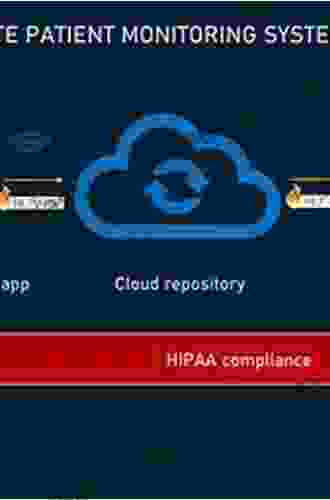Systems Design for Remote Healthcare: Enhancing Accessibility and Continuity of Care

4.6 out of 5
| Language | : | English |
| File size | : | 9836 KB |
| Text-to-Speech | : | Enabled |
| Screen Reader | : | Supported |
| Enhanced typesetting | : | Enabled |
| Print length | : | 350 pages |
Remote healthcare, encompassing telehealth and telemedicine, is transforming the landscape of healthcare delivery by enabling patients to receive medical care from the comfort of their own homes. By leveraging technology, remote healthcare systems overcome geographical barriers, facilitate timely access to healthcare services, and promote continuity of care for patients with limited mobility or those residing in underserved areas.
However, designing effective systems for remote healthcare poses unique challenges that require careful consideration. This article delves into the essential principles and considerations for designing robust and patient-centered systems that meet the specific demands of remote care delivery.
Technological Infrastructure
A robust technological infrastructure is the backbone of any remote healthcare system. This includes selecting and integrating various components, such as:
1. Telecommunication Platforms: Reliable and high-quality telecommunication platforms ensure seamless communication between healthcare providers and patients. These platforms should support real-time audio and video conferencing, enabling face-to-face interactions and remote consultations.
2. Medical Devices and Sensors: Remote healthcare often involves the use of medical devices and sensors to collect patient data. These devices may include blood pressure monitors, glucose meters, and electrocardiogram (ECG) devices. Integration with the system facilitates remote monitoring and data analysis.
3. Electronic Health Records (EHRs): EHRs serve as central repositories for patient health information. Remote healthcare systems must seamlessly integrate with EHRs to provide healthcare providers with access to patient records, test results, and medical history.
4. Cloud Computing: Cloud computing offers flexibility, scalability, and cost-effectiveness for remote healthcare systems. It allows for secure storage and sharing of patient data, remote access to applications, and collaboration among healthcare teams.
User Experience
User experience (UX) plays a pivotal role in the adoption and satisfaction of remote healthcare systems. Key considerations include:
1. Accessibility and Navigation: Systems should be designed to be accessible to users of all backgrounds and abilities. Intuitive navigation and clear interfaces ensure that patients and healthcare providers can easily find the information and services they need.
2. User-Friendly Interfaces: User-friendly interfaces make it easy for patients to use and understand the system. This includes using simple language, providing clear instructions, and minimizing technical jargon.
3. Mobile Optimization: Mobile optimization is crucial as many patients access remote healthcare services through smartphones or tablets. Systems should be responsive and adaptive to different screen sizes.
4. Data Visualization: Data visualization tools help patients understand their health data and make informed decisions. Interactive dashboards and graphical representations provide easy-to-interpret insights into their health status.
Data Security and Privacy
Data security and privacy are paramount in remote healthcare systems due to the sensitive nature of patient information. Essential measures include:
1. Encryption: Encryption safeguards patient data from unauthorized access during transmission and storage. Strong encryption algorithms protect both patient health information and medical images.
2. Compliance with Regulations: Healthcare organizations must comply with relevant regulations, such as HIPAA (Health Insurance Portability and Accountability Act) and GDPR (General Data Protection Regulation). These regulations outline strict guidelines for data handling, use, and disclosure.
3. Multi-Factor Authentication: Multi-factor authentication adds an extra layer of security by requiring users to provide multiple forms of identification before accessing the system.
4. Regular Security Audits: Regular security audits identify and address vulnerabilities within the system. They help ensure ongoing protection against cyber threats.
Clinical Workflow and Patient Engagement
Effective remote healthcare systems support efficient clinical workflows and promote patient engagement:
1. Telehealth Integration: Telehealth integration allows healthcare providers to conduct virtual consultations, monitor patients remotely, and provide timely interventions.
2. Patient Self-Management Tools: Patient self-management tools empower patients to actively participate in their care. These tools may include symptom trackers, medication reminders, and educational resources.
3. Care Coordination: Systems should facilitate care coordination among multiple healthcare providers, ensuring seamless transitions between different care settings.
4. Patient Education: Patient education plays a vital role in remote healthcare. Systems should provide access to reliable health information and support materials to empower patients with knowledge.
Systems design for remote healthcare involves a multifaceted approach that encompasses technological infrastructure, user experience, data security, and clinical workflow considerations. By carefully addressing these aspects, healthcare providers can develop robust and patient-centered systems that offer increased accessibility, continuity of care, and improved health outcomes.
As remote healthcare continues to evolve, ongoing research and innovation will further refine and enhance these systems. By embracing technological advancements and prioritizing patient-centric design, the healthcare industry can unlock the full potential of remote healthcare and deliver high-quality care to patients anytime, anywhere.
4.6 out of 5
| Language | : | English |
| File size | : | 9836 KB |
| Text-to-Speech | : | Enabled |
| Screen Reader | : | Supported |
| Enhanced typesetting | : | Enabled |
| Print length | : | 350 pages |
Do you want to contribute by writing guest posts on this blog?
Please contact us and send us a resume of previous articles that you have written.
 Fiction
Fiction Non Fiction
Non Fiction Romance
Romance Mystery
Mystery Thriller
Thriller SciFi
SciFi Fantasy
Fantasy Horror
Horror Biography
Biography Selfhelp
Selfhelp Business
Business History
History Classics
Classics Poetry
Poetry Childrens
Childrens Young Adult
Young Adult Educational
Educational Cooking
Cooking Travel
Travel Lifestyle
Lifestyle Spirituality
Spirituality Health
Health Fitness
Fitness Technology
Technology Science
Science Arts
Arts Crafts
Crafts DIY
DIY Gardening
Gardening Petcare
Petcare Florence Littauer
Florence Littauer Paul H Wender
Paul H Wender Saul Greenberg
Saul Greenberg Rose Kelly
Rose Kelly Paul J Zak
Paul J Zak Zenas Leonard
Zenas Leonard Robert Nye
Robert Nye Marsha M Linehan
Marsha M Linehan Dan John
Dan John Dr Hooelz
Dr Hooelz Judy Corry
Judy Corry Matt Bronsil
Matt Bronsil Jamie Thom
Jamie Thom Neva Sullaway
Neva Sullaway Carl Nattrass
Carl Nattrass Anne Griffin Perry
Anne Griffin Perry Lee Carroll
Lee Carroll Frank M Snowden
Frank M Snowden Phillip E Johnson
Phillip E Johnson Terri Schneider
Terri Schneider Jacob Biggle
Jacob Biggle C Rich
C Rich David Hart
David Hart Kate Jones
Kate Jones Abdi Nazemian
Abdi Nazemian Marie Lu
Marie Lu Michelle Mullen
Michelle Mullen Casey Mcquiston
Casey Mcquiston John Powers
John Powers Peter Grey
Peter Grey Johnny Weir
Johnny Weir David C M Dickson
David C M Dickson Jacqueline Boyle
Jacqueline Boyle Johnny Chuong
Johnny Chuong Frank Burtnett
Frank Burtnett Anne Lamott
Anne Lamott Randy Ribay
Randy Ribay Proper Education Group
Proper Education Group Cylin Busby
Cylin Busby Greg Jacobs
Greg Jacobs Richard Allen
Richard Allen Kay West
Kay West Kristen Welch
Kristen Welch Keith Devlin
Keith Devlin Ruth Ravid
Ruth Ravid Rory D Nelson
Rory D Nelson Stanley H Block
Stanley H Block Herbert Dorsey
Herbert Dorsey Thema Bryant Davis
Thema Bryant Davis Michael Wombacher
Michael Wombacher Gabrielle Walker
Gabrielle Walker Danya Ruttenberg
Danya Ruttenberg C G Yeager
C G Yeager Margaret L Lial
Margaret L Lial Chuck Tingle
Chuck Tingle Thor Heyerdahl
Thor Heyerdahl Shyam Bharath S D
Shyam Bharath S D Jody Studdard
Jody Studdard Robert Weintraub
Robert Weintraub Lucy Sutcliffe
Lucy Sutcliffe Stephen Rodrick
Stephen Rodrick Lucie Hemmen
Lucie Hemmen Mike Ashley
Mike Ashley Lisa Delmedico Harris
Lisa Delmedico Harris Aarron Davis
Aarron Davis Paul Nardozzi
Paul Nardozzi Jolene Stockman
Jolene Stockman Janet Lansbury
Janet Lansbury Consumer Dummies
Consumer Dummies Julie Kagawa
Julie Kagawa Ken Shamrock
Ken Shamrock Ronald W Kipp
Ronald W Kipp Joel Gunderson
Joel Gunderson David G Mcafee
David G Mcafee C Mo
C Mo Ed Housewright
Ed Housewright Lynn Marriott
Lynn Marriott Companion Works
Companion Works Kimberly D Coleman
Kimberly D Coleman Phil Richards
Phil Richards David H Stern
David H Stern Micheal J Murphy
Micheal J Murphy New England Wild Flower Society
New England Wild Flower Society Melinda Sharma
Melinda Sharma Susan H Kamei
Susan H Kamei Anne Crossman
Anne Crossman Sue Dumais
Sue Dumais Supersummary
Supersummary Jules Archer
Jules Archer Lena Empyema
Lena Empyema Annie Duke
Annie Duke Anthea Sharp
Anthea Sharp Lexie Williamson
Lexie Williamson Norm Zeigler
Norm Zeigler Annie Vernon
Annie Vernon Christine Gross Loh
Christine Gross Loh David Hume
David Hume Katie Hewett
Katie Hewett Kevin Keitoshi Casey
Kevin Keitoshi Casey Lamar Underwood
Lamar Underwood Ashild Kolas
Ashild Kolas Marcia Nathai Balkissoon
Marcia Nathai Balkissoon Jessica Megan Larson
Jessica Megan Larson Margaret Bemister
Margaret Bemister Rick Brinkman
Rick Brinkman Dustin Brady
Dustin Brady Sean Moloney
Sean Moloney K Loraine
K Loraine Mark Murphy
Mark Murphy Don Cherry
Don Cherry Melinda Cooper
Melinda Cooper M J Ryan
M J Ryan Dr Harrison Sachs
Dr Harrison Sachs The Tutorverse
The Tutorverse Sali Hughes
Sali Hughes Justin J Lehmiller
Justin J Lehmiller Annie Murphy Paul
Annie Murphy Paul William S Vincent
William S Vincent Tim Sullivan
Tim Sullivan Jake Byrne
Jake Byrne Daniel Barbarisi
Daniel Barbarisi David Mcgowan
David Mcgowan Michael Bernick
Michael Bernick Raye Wagner
Raye Wagner Donald Asher
Donald Asher Rabbi Jason Sobel
Rabbi Jason Sobel Md Nazaneen Homaifar
Md Nazaneen Homaifar Stephen Kendrick
Stephen Kendrick Annemarie Brear
Annemarie Brear Michael Lieberman
Michael Lieberman Nat Brown
Nat Brown Shaun Gallagher
Shaun Gallagher Yury Kronn
Yury Kronn Annie Brock
Annie Brock Derek C Hutchinson
Derek C Hutchinson Jack Thurston
Jack Thurston Francis Su
Francis Su Douglas Boze
Douglas Boze Madeleine Boskovitz Ph D
Madeleine Boskovitz Ph D W Ben Hunt
W Ben Hunt Isee Exam Preparation Experts
Isee Exam Preparation Experts Josh Alwine
Josh Alwine Ascencia Pharmacy Technician Exam Prep Team
Ascencia Pharmacy Technician Exam Prep Team L J Smith
L J Smith David Long
David Long David M Carballo
David M Carballo Joshua M Powell
Joshua M Powell Anne Winkler Morey
Anne Winkler Morey Rachel Macy Stafford
Rachel Macy Stafford Anne Garrels
Anne Garrels John U Bacon
John U Bacon New Scientist
New Scientist Carl Hiaasen
Carl Hiaasen Marcus Engel
Marcus Engel Teri Halstead Rn Msn
Teri Halstead Rn Msn Jaron Lanier
Jaron Lanier Mamma Margaret
Mamma Margaret John Michael Greer
John Michael Greer James Lock
James Lock Fazale Rana
Fazale Rana Richard Preston
Richard Preston Sir Francis Chichester
Sir Francis Chichester Tomohito Oda
Tomohito Oda Jerry A Pattengale
Jerry A Pattengale Ed Van Put
Ed Van Put Iain Campbell
Iain Campbell Heather Atkinson
Heather Atkinson Anne Mctiernan
Anne Mctiernan Shing Yin Khor
Shing Yin Khor Dana Meachen Rau
Dana Meachen Rau Matilda Joslyn Gage
Matilda Joslyn Gage Yani Alfonso
Yani Alfonso Caroline D Greene
Caroline D Greene Christopher D Winnan
Christopher D Winnan Jean Markale
Jean Markale Mjg Education
Mjg Education Jean Liedloff
Jean Liedloff Harvey Karp
Harvey Karp Michael Werner
Michael Werner John N Carbone
John N Carbone Traci B Fox
Traci B Fox Anne Blythe
Anne Blythe Ralph Henry Barbour
Ralph Henry Barbour P G Wodehouse
P G Wodehouse Doug Knutson
Doug Knutson Kay L Moody
Kay L Moody Joe Samuel Starnes
Joe Samuel Starnes Vanessa Van Edwards
Vanessa Van Edwards Sheril Kirshenbaum
Sheril Kirshenbaum Richard Freeman
Richard Freeman Dean Karlan
Dean Karlan Srinivasan S Pillay
Srinivasan S Pillay Kathleen M Galvin
Kathleen M Galvin Jennifer Berne
Jennifer Berne Jamie Davis
Jamie Davis Joseph Mctaggart
Joseph Mctaggart Brandon Sieh
Brandon Sieh John Allen Paulos
John Allen Paulos Ernest Nagel
Ernest Nagel Graham Poll
Graham Poll Thomas Celentano
Thomas Celentano William Johnston
William Johnston Kathleen Kirkland
Kathleen Kirkland Sarah Luddington
Sarah Luddington Heath Lambert
Heath Lambert Zoeunlimited
Zoeunlimited Bill Plotkin
Bill Plotkin John Mole
John Mole Vijay Prashad
Vijay Prashad Michael Higgins
Michael Higgins Dave Bosanko
Dave Bosanko Joshua Lawrence Kinser
Joshua Lawrence Kinser Lavinia Spalding
Lavinia Spalding Julian Savulescu
Julian Savulescu Eddie Rafii
Eddie Rafii Jeffrey Rubin
Jeffrey Rubin Annette Dixon
Annette Dixon Bianca Scardoni
Bianca Scardoni Jamie D Roberts Lmft
Jamie D Roberts Lmft Richmond Campbell
Richmond Campbell Jackson Carter
Jackson Carter Darren Levine
Darren Levine Julie Hall
Julie Hall Julia Cook
Julia Cook Trina Boice
Trina Boice Skeleton Steve
Skeleton Steve Richard Evans
Richard Evans Vincent J Monastra
Vincent J Monastra Magoosh
Magoosh Steve Mcmichael
Steve Mcmichael Susan Dexter
Susan Dexter David W Shaw
David W Shaw Kj Dell Antonia
Kj Dell Antonia Gerald Marzorati
Gerald Marzorati Stan Byrdy
Stan Byrdy Paul Wilbur
Paul Wilbur Mishka Shubaly
Mishka Shubaly Ken Siri
Ken Siri Jack Petrash
Jack Petrash Christo Obreschkow
Christo Obreschkow Laura Hillenbrand
Laura Hillenbrand Marie W Lawrence
Marie W Lawrence Audiolearn Content Team
Audiolearn Content Team Olivia Seltzer
Olivia Seltzer Tarl Warwick
Tarl Warwick Meg Meeker
Meg Meeker Steve Currier
Steve Currier Shannon Allen
Shannon Allen Steven Harrison
Steven Harrison Johnson Smith
Johnson Smith Erika Larkin
Erika Larkin Giovanni Bennardo
Giovanni Bennardo Martin Lees
Martin Lees Jean Watson
Jean Watson Theodore M Porter
Theodore M Porter William A Richards
William A Richards Patrick Leigh Fermor
Patrick Leigh Fermor Jd Long
Jd Long Sarah Beeson
Sarah Beeson Britta Wallace
Britta Wallace Maria Del Mar Sacasa
Maria Del Mar Sacasa Creek Stewart
Creek Stewart Roger Eckstine
Roger Eckstine Elia Kacapyr
Elia Kacapyr Notesbo Funny
Notesbo Funny Wiley Mccrary
Wiley Mccrary Eduardo Kohn
Eduardo Kohn Anneli Williams
Anneli Williams Aw Schultz
Aw Schultz Julian Winters
Julian Winters Jim Meuninck
Jim Meuninck Hans Florine
Hans Florine David Lindley
David Lindley Shirley Davis Brown
Shirley Davis Brown Joe Borelli
Joe Borelli Bruce Bryans
Bruce Bryans Susan Ee
Susan Ee Francheska Fifield
Francheska Fifield Simon Gawesworth
Simon Gawesworth Dave Heller
Dave Heller Thomas Settimi
Thomas Settimi Kevin Fall
Kevin Fall Monica Seles
Monica Seles Colm Cooper
Colm Cooper R I Chalmers
R I Chalmers Bobby Bowden
Bobby Bowden Helena Hjalmarsson
Helena Hjalmarsson Steve Mchugh
Steve Mchugh Belden C Lane
Belden C Lane Kelly St Clare
Kelly St Clare Christopher Van Tilburg
Christopher Van Tilburg Fred Shoemaker
Fred Shoemaker Sara Bennett
Sara Bennett Steve Schwartz
Steve Schwartz Geoff Greig
Geoff Greig John J Donohue
John J Donohue Bryan Greetham
Bryan Greetham Annette Evans
Annette Evans Gareth Ainsworth
Gareth Ainsworth Anthony Edwards
Anthony Edwards William J Knaus
William J Knaus Babette A Brumback
Babette A Brumback Kelly Oram
Kelly Oram Michelle Obama
Michelle Obama I Randolph Daniel
I Randolph Daniel Claire Legrand
Claire Legrand Eric Stice
Eric Stice Zohar Ben Shoham
Zohar Ben Shoham Kim Hutchinson
Kim Hutchinson Svetlana Boym
Svetlana Boym Marilynn Hughes
Marilynn Hughes Peter Lipton
Peter Lipton Michael Volkmar
Michael Volkmar Pedro J Izquierdo
Pedro J Izquierdo Bradley Wiggins
Bradley Wiggins Laurence Parent
Laurence Parent Annie Thoms
Annie Thoms Scott Ellsworth
Scott Ellsworth Tom Hull
Tom Hull Benjamin Wiker
Benjamin Wiker David Cayley
David Cayley T K Richardson
T K Richardson Kerry Andy Ph D
Kerry Andy Ph D Julian Thomas
Julian Thomas T Edward Nickens
T Edward Nickens Elizabeth Pantley
Elizabeth Pantley Ross W Greene
Ross W Greene Herb Payson
Herb Payson Whitney Stewart
Whitney Stewart Merlisa Lawrence Corbett
Merlisa Lawrence Corbett Kristina Kuzmic
Kristina Kuzmic Claire Fraise
Claire Fraise Stephen White
Stephen White Brian J Sorrells
Brian J Sorrells La Leche League International
La Leche League International Julie Foudy
Julie Foudy Leslie Scrivener
Leslie Scrivener Marcia L London
Marcia L London Patrick Mansell
Patrick Mansell Rina Mae Acosta
Rina Mae Acosta Bert Randolph Sugar
Bert Randolph Sugar Tom Clynes
Tom Clynes Peter Walker
Peter Walker David Sheff
David Sheff Jackie Bolen
Jackie Bolen Russ King
Russ King Emily L Casanova
Emily L Casanova Spencer Langley
Spencer Langley Jim Zub
Jim Zub David Norrie
David Norrie Christie Matheson
Christie Matheson Ken Bain
Ken Bain R Michael Shaft
R Michael Shaft Chad Noreuil
Chad Noreuil Sabrina Sargent
Sabrina Sargent Bob Seshadri
Bob Seshadri Bob Mullen
Bob Mullen George M Marsden
George M Marsden Del Hungerford
Del Hungerford Jacob Erez
Jacob Erez Julie Schoen
Julie Schoen Wayne L Winston
Wayne L Winston Jennifer L Lopez
Jennifer L Lopez Sasha Sagan
Sasha Sagan Carter G Walker
Carter G Walker John Snygg
John Snygg Christopher Paolini
Christopher Paolini Reia
Reia Lorraine Evans
Lorraine Evans Timothy Egan
Timothy Egan Critical Role
Critical Role Nancy Forbes
Nancy Forbes Robert Kaplinsky
Robert Kaplinsky Laura Warren Hill
Laura Warren Hill Marlo Thomas
Marlo Thomas Michael Howard
Michael Howard Anne Arthur
Anne Arthur Michael A Stackpole
Michael A Stackpole Wilfred Cude
Wilfred Cude Karen Simmers Nartker
Karen Simmers Nartker Jacalyn Duffin
Jacalyn Duffin Glen Simmons
Glen Simmons Gareth James
Gareth James Billy Hansen
Billy Hansen Jan D Carline
Jan D Carline John R Anderson
John R Anderson Kris Hampton
Kris Hampton Richard Sale
Richard Sale Harlan Cohen
Harlan Cohen Douglas R Dechow
Douglas R Dechow Barry Meadow
Barry Meadow Chella Quint
Chella Quint Peter C Earle
Peter C Earle Ben Alexander
Ben Alexander Cindy Pawlcyn
Cindy Pawlcyn Mana Takahashi
Mana Takahashi Bernard Ollivier
Bernard Ollivier Shanna Swendson
Shanna Swendson Judy Arnall
Judy Arnall Dr Julie Shannon
Dr Julie Shannon Jeff Feldhahn
Jeff Feldhahn Francis French
Francis French Jon Cohen
Jon Cohen Annie Boochever
Annie Boochever Ted Leeson
Ted Leeson Gail Fay
Gail Fay Olly Postanin
Olly Postanin Tanya Lloyd Kyi
Tanya Lloyd Kyi David Shoemaker
David Shoemaker Frost Kay
Frost Kay Peter Turchin
Peter Turchin Kristi Hugstad
Kristi Hugstad Tim Grollimund
Tim Grollimund Hiro Fujiwara
Hiro Fujiwara Daniele Bolelli
Daniele Bolelli Ted Starkey
Ted Starkey David Hoffbrand
David Hoffbrand Victoria Biggs
Victoria Biggs Maxine Van Evera Lupo
Maxine Van Evera Lupo Kathryn Cadenhead Colgrove
Kathryn Cadenhead Colgrove William Rathje
William Rathje Chris Creamer
Chris Creamer Joshua Piven
Joshua Piven Kindle Edition
Kindle Edition Henry Treece
Henry Treece David Foster Wallace
David Foster Wallace Al Beatty
Al Beatty Annette Lareau
Annette Lareau Tim Hill
Tim Hill Christopher F Chabris
Christopher F Chabris Dr Deirdre Clark
Dr Deirdre Clark Courtney Mayer
Courtney Mayer Gary Genard
Gary Genard Anne Laure Jackson
Anne Laure Jackson Patty Bear
Patty Bear Glenn Adamson
Glenn Adamson Colleen Macklin
Colleen Macklin Ric K Hill
Ric K Hill Nicholas Johnson
Nicholas Johnson Ben Stoeger
Ben Stoeger Jennifer Raff
Jennifer Raff Sarah Kowalski
Sarah Kowalski Deborah Ellis
Deborah Ellis Shannon Lee
Shannon Lee Eric J Mash
Eric J Mash Tony Nester
Tony Nester Jack Challoner
Jack Challoner Barbara Savage
Barbara Savage Edward Espe Brown
Edward Espe Brown Marv Wolfman
Marv Wolfman Jo Wimpenny
Jo Wimpenny Lamorna Ash
Lamorna Ash Jak Beardsworth
Jak Beardsworth Jeffrey E F Friedl
Jeffrey E F Friedl Rick August
Rick August Lady Gaga
Lady Gaga Lorne Rubenstein
Lorne Rubenstein Shea Serrano
Shea Serrano Daniel L Bray
Daniel L Bray Kathryn Aalto
Kathryn Aalto Richard Watts
Richard Watts Henry Stedman
Henry Stedman Charles L Byrne
Charles L Byrne Desmond Morris
Desmond Morris Vic Widman
Vic Widman Luke Amadeus Ranieri
Luke Amadeus Ranieri Kass Morgan
Kass Morgan Barney Scout Mann
Barney Scout Mann Lynn Painter
Lynn Painter Warren Hilton
Warren Hilton Tella Olayeri
Tella Olayeri Allistair Mccaw
Allistair Mccaw Steven M Rice
Steven M Rice Beth Jacobs Phd
Beth Jacobs Phd Ron Fry
Ron Fry Ryan T White
Ryan T White Henry Malone
Henry Malone Anthony E Wolf
Anthony E Wolf Filipe Masetti Leite
Filipe Masetti Leite Leo Furcht
Leo Furcht Bill Shipley
Bill Shipley Shelley Emling
Shelley Emling Michael Mckinley
Michael Mckinley
Light bulbAdvertise smarter! Our strategic ad space ensures maximum exposure. Reserve your spot today!
 Desmond FosterFollow ·16.7k
Desmond FosterFollow ·16.7k Oscar WildeFollow ·19.2k
Oscar WildeFollow ·19.2k John KeatsFollow ·5.1k
John KeatsFollow ·5.1k Josh CarterFollow ·13.3k
Josh CarterFollow ·13.3k Cortez ReedFollow ·14.2k
Cortez ReedFollow ·14.2k Arthur Conan DoyleFollow ·9k
Arthur Conan DoyleFollow ·9k Bob CooperFollow ·10.8k
Bob CooperFollow ·10.8k Harvey HughesFollow ·17.9k
Harvey HughesFollow ·17.9k

 George Martin
George MartinWildcard Warcross by Marie Lu: The Ultimate Guide to the...
Wildcard Warcross, the...

 Houston Powell
Houston PowellMountaineering Madness: The Deadly Race to Summit the...
The Himalayas, towering over the...

 Levi Powell
Levi PowellNonparametric Statistical Inference: A Comprehensive...
Nonparametric statistical inference is a...

 Salman Rushdie
Salman RushdieManfish: The Extraordinary Story of Jacques Cousteau, the...
Early Life and Diving Experiments ...

 Ross Nelson
Ross NelsonThe Sweet Spot: Great Golf Starts Here
Welcome to The Sweet Spot,...
4.6 out of 5
| Language | : | English |
| File size | : | 9836 KB |
| Text-to-Speech | : | Enabled |
| Screen Reader | : | Supported |
| Enhanced typesetting | : | Enabled |
| Print length | : | 350 pages |













